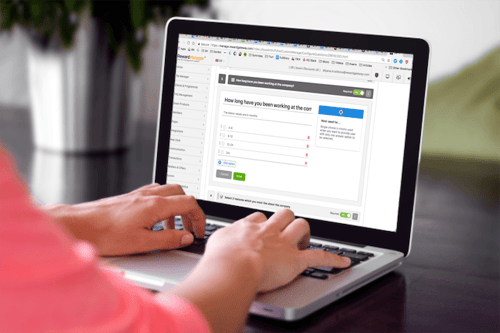-1.jpg?width=500&name=Adam%20Barley-4231%20(1)-1.jpg)
5 min read
Before I joined Reward Gateway and became our internal communications manager, I assumed a People Team strategy and employee insights largely came from one seemingly valuable tool: An annual employee survey.
I wasn’t necessarily wrong. Many rely on annual surveys to get a “temperature check” of how their business is doing and use those findings to create attainable People Team goals — improve engagement, boost their employer brand, find better benefits … and so on and so on.
But here’s the problem with the annual survey: It can’t, and never will, magically tell you what happens the other 364 other days of the year.
What does employee survey best practice mean, then? We need consistent insight so we can pivot and change with our employees and the company as a whole. While our internal communications platform helps me keep eyes on what’s happening among our 375+ employees, in my dreams, we needed a way to send and review our employee engagement surveys, and I needed a way to boost engagement on those surveys overall.
Let’s go back to the annual survey. To me, this meant surveys being sent out via email which meant my work was repeatedly interrupted by colleagues who had lost, deleted or not received the survey to their inbox. How many times did I hear “Cat, where’s that link?”!
Oh, let me count the ways.
I’ll be honest with you, I was pretty glad when the survey closed and my messenger finally stopped pinging.
At Reward Gateway though, we value open and honest communication, and there had to be ways to let our employees speak up (one of our core values). So we created the Speak Up page, which had a simple feedback form that dropped an email to us. Employees could contact us when they wanted and we’d respond as needed. Yes, it was more frequent, but the basic process meant we lost any way to measure our impact and progress.
With employees simply emailing us their feedback there was no consistency. Emailing us told us the problem but without any context to the data submitted aside the one piece of feedback presented at that time it meant we became more reactive than proactive.
With multiple methods came multiple headaches.
And while it (sort of) solved our feedback issue, there was still confusion around what actions to take, and what impact those actions would have. I wasn’t alone — in speaking with our Client Success Managers, we learned that so many organizations weren’t sure if they were starting in the right place on their engagement journey, and as HR professionals, we all want to know that we’re making the right decisions to improve employee engagement.
And so we came up with one super-survey product, and I’m really pleased to share it with you today.

Introducing: Employee surveys
Today, we're launching our newest product, employee surveys.
(Or, as I like to call it: the Employee Engagement Strategy Dream Machine)
Let me tell you first how it work in terms of all the technical bits…
- You set up a survey. You can have either NPS (One of our favorite ways to survey and measure progress at RG), or you can build your own survey - use one of our templates or start from scratch.
- Once you’ve got your questions in order, you set the date for it to open and close (we recommend two weeks). Next, set how you want your employees to receive it. This could be via email or, if you’d like, a web link that you can send out through your social media channels, on your employee engagement platform or even via text message.
Worried about those laggers who take ages to answer? We’ve got a special boost button, one click from you and it’ll remind them exactly what they need to do.
Tying it all together
Once the survey is closed and you’ve got all your responses, that’s when the real magic happens.
Using the data you’ve collated you’ll be able to find key trends. Rather than pulling information from all different sources, you can quickly spot current themes, from all areas of your business, in one place. Use the survey tools to get your “front-line” responses, and marry those with insight on company strategy from your Leadership Team — make those connections and you’ll produce a match made in heaven.
Sound like something you could use? Check out how one of our clients use the tool to gain valuable insight to drive their own engagement strategy forward, and request a demo of yours today. I’ll be back here soon with more tips on getting the most out of your employee surveys.

 Catrin Lewis
Catrin Lewis



